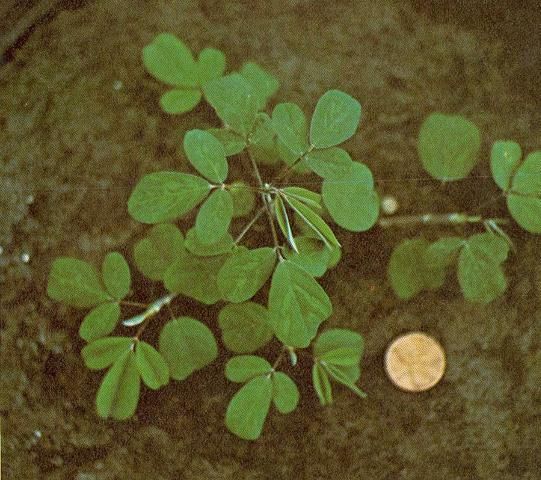Florida carpon desmodium (Desmodium heterocarpon; Figure 1) is a perennial, herbaceous, warm-season legume adapted to South Florida. It has creeping to ascending stems that may be more than 40 inches long. The leaves usually have three leaflets, but leaves with a single leaflet may be found on the lower stems of mature plants and on seedlings. The leaves usually have three leaflets, but leaves with a single leaflet may be found on the lower stems of mature plants and on seedlings. Leaflets are smooth on the upper surface but hairy on the lower surface. Leaflets usually have a light green to yellow "watermark." On a dense flower stalk, pinkish flowers originate from axillary or terminal racemes. Pods are erect or ascending, narrowly oblong, compressed, and have 4 to 8 jointed segments. Pods turn from green to dark brown as they mature. Seed pods adhere to animals and to clothing.

Credit: UF/IFAS
Adaptation
Carpon desmodium is adapted to most flatwood soils. However, establishment failures may occur on sites susceptible to flooding, if flooding occurs during the early seedling stage. Seedlings are vulnerable to both short-term flooding and drought. However, established plants can tolerate excessive moisture as well as severe spring drought. Approximately 65% of carpon desmodium's growth in Florida takes place from summer to early fall. The remaining 30% occurs in the spring and only 5% during the rest of the year.
Quality
The foliage of carpon desmodium contains 12 to 20% crude protein. Carpon-bahiagrass mixtures have a crude protein concentration of approximately 10% and an in-vitro organic matter digestibility of 50% Biologically fixed nitrogen in a mixture with bahiagrass normally ranges from the equivalent of 30 to 75 lb/A of nitrogen. Carpon desmodium adds nitrogen to a warm-season perennial pasture system by the recycling of senescent leaves or through cattle excreta. Nitrogen fixation by carpon desmodium can be decreased if the plants are excessively grazed or receive nitrogen fertilization.
Establishment
Carpon desmodium seed is very small in size and should be planted no deeper than one-half inch. A cleaned-tilled seedbed is recommended for carpon desmodium establishment. A system of rolling, broadcasting of seed, and re-rolling ensures that seed is not planted deeper than one-half inch. Another consideration of seeding carpon is to plant it when establishing bahiagrass on a clean soil. Where there is an existing grass sod, heavy grazing prior to light disking or chopping should precede the initial rolling, followed again by broadcasting and rolling. Another option for establishment is to burn the grass sod in late February, broadcast seed in the ash, followed by light disking and rolling. Recommended seeding rates are 3 to 5 lb/A on a clean-tilled seedbed and 5 to 10 lb/A on established grass sod. In Florida, sowing between March and April may yield early establishment and harvestable seed production in the first year but with an associated risk of extended periods of drought (April to May), which may result in establishment failure. Sowing in midsummer increases the chance of adequate rainfall but has an associated risk of greater grass competition and seedling loss from extended flooding. A compromise may be to seed in May or early June. Another potential hazard to establishment of carpon desmodium is susceptibility of seedlings to root-knot nematode, especially following a vegetable crop. On vegetable fields, it is advantageous to make small trial plantings to assess nematode hazards before sowing extensive areas. Cowpea-type inoculum is recommended when sowing on areas that were not previously cultivated with legumes.
Fertilization
The adequate soil pH for carpon desmodium is 6.0. If the soil tests low in phosphorus and potassium, add 0-30-60 lb/A of N-P2O5-K2O fertilizer annually or according to the soil test recommendation. It is not recommended to add N fertilization on areas planted with carpon desmodium. Additional fertilization information can be found at the EDIS SS163 publication UF/IFAS Standardized Fertilization Recommendations for Agronomic Crops (https://edis.ifas.ufl.edu/ss163).
Management
During spring and early summer, when moisture is limited, bahiagrass regrowth must be heavily grazed to reduce grass competition on the legume. From late summer through the fall, lighter grazing pressure associated with rotational grazing is beneficial to improve carpon desmodium persistence. Because 65% of the legume growth occurs from late summer through fall, a rest period provides an opportunity for the plant to improve vigor, support biological nitrogen fixation, and accumulate forage for greater intake of legume by cattle in subsequent grazing periods. Even when seed harvest is not intended, restricting grazing enough to allow some seed to set in the fall is important to maintain stands since individual carpon desmodium plants do not live indefinitely. Managing the two processes of seed set in the fall and summer seedling establishment within a population of perennial plants can help maintain a stable carpon desmodium-bahiagrass plant population. The key advantage of carpon desmodium over annual legumes, such as aeschynomene, is individual-plant long-term persistence and tolerance to periodic grazing abuse.
Seed Production
Management of carpon desmodium for seed is compatible with improved nitrogen fixation. The technique involves reduction in/or deferment of grazing for a prolonged period that extends from early August through November, when seed is harvested. Flowering begins in early September, a concentrated seed set occurs in late October, and seed maturation is completed by mid-November. Mature pods do not shatter readily, but seed from grass-legume mixtures should be harvested when 85–90% of the pods are mature.